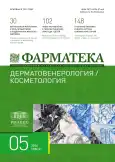Etiopathogenetic aspects of rosacea
- 作者: Ayupova K.R.1, Yusupova L.A.1
-
隶属关系:
- Kazan State Medical Academy – Branch Campus of the Russian Medical Academy of Continuous Professional Education
- 期: 卷 31, 编号 5 (2024)
- 页面: 61-65
- 栏目: Reviews
- URL: https://journal-vniispk.ru/2073-4034/article/view/267800
- DOI: https://doi.org/10.18565/pharmateca.2024.5.61-65
- ID: 267800
如何引用文章
详细
Rosacea is a chronic inflammatory disease that is common among fair-skinned individuals of Northern European descent. The etiopathogenetic mechanisms of rosacea are multifactorial, including contributions from both innate and adaptive immunity. Inflammation can be caused by impaired neurovascular regulation, changes and dilation of small blood vessels, imbalances in the skin microbiome, genetic factors, and environmental triggers. Ultraviolet radiation and temperature changes are significant environmental factors contributing to vascular changes in predisposed patients with rosacea. The interaction between ultraviolet radiation and atomic oxygen produces reactive oxygen species, forming the inflammatory cascade of rosacea pathogenesis.
作者简介
K. Ayupova
Kazan State Medical Academy – Branch Campus of the Russian Medical Academy of Continuous Professional Education
编辑信件的主要联系方式.
Email: skinderma@rambler.ru
ORCID iD: 0000-0002-2179-1214
PhD candidate, Department of Dermatovenereology and Cosmetology
俄罗斯联邦, KazanL. Yusupova
Kazan State Medical Academy – Branch Campus of the Russian Medical Academy of Continuous Professional Education
Email: skinderma@rambler.ru
ORCID iD: 0000-0001-8937-2158
SPIN 代码: 5743-6872
俄罗斯联邦, Kazan
参考
- Alexis A.F., Callender V.D., Baldwin H.E., et al. Global epidemiology and the clinical spectrum of rosacea, highlighting skin of color: a Review and experience of clinical practice experience. J Am Acad Dermatol. 2019;80(6):1722–29.
- Аюпова К.Р., Юсупова Л.А. Современные особенности патогенетических механизмов розацеа. Фарматека. 2022;29(8):43–7. [Ayupova K.R., Yusupova L.A. Modern features of the pathogenetic mechanisms of rosacea. Farmateka. 2022;29(8):43–7. (In Russ.)]. doi: 10.18565/pharmateca.2022.8.43-47.
- Юсупова Л.А. Современное состояние проблемы эксфолиативного дерматита. Лечащий врач. 2019;11:6–8 [Yusupova L.A. The current state of the problem of exfoliative dermatitis. Lechashchii vrach. 2019;11:6–8. (In Russ.)].
- Zujko-Kowalska K., Maslowska J., Knas-Dawidziuk M., et al. Dietary antioxidants may support cosmetic treatment of patients with rosacea. Antioxidants (Basel). 2024;13(3):381.
- Кажжанова А.М., Юсупова Л.А. Патогенетические механизмы гнездной алопеции. Фарматека. 2023; 29(8):47–51. [Kazhzhanova A.M., Yusupova L.A. Patogeneticheskie mekhanizmy gnezdnoj alopecii. Farmateka. 2023;29(8):47–51. (In Russ.)]. doi: 10.18565/pharmateca.2023.8.47-51.
- Turkmen D. Serum bilirubin and uric acid antioxidant levels in rosacea patients. J Cosmet Dermatol. 2020;19(10):2717–20.
- Юсупова Л.А. Современный взгляд на проблему старения кожи. Лечащий врач. 2017;6:75. [Yusupova L.A. Modern view on the problem of skin aging. Lechashchii vrach. 2017;6:75. (In Russ.)]
- Halioua B., Cribier B., Frey M., Tan J. A sense of stigmatization in patients with rosacea. J Eur Acad Dermatol Venerol. 2017;31(1):163–68.
- Yang F., Zhang K., Song D., et al. A cross-sectional study on the relationship between rosacea severity and quality of life or psychological state. Clin Cosmet Investing Dermatol. 2022;15:2807–16.
- Yamasaki K., Miyachi Yu. Perspectives on rosacea patient characteristics and quality of life using baseline data from a phase 3 clinical study conducted in Japan. J Dermatol. 2022;49: 1221–27.
- Geng R.S.Q, Bourkas A.N., Mufti A.N., Sibbalt R.G. Rosacea: pathogenesis and therapeutic correlates. J Cutan Med Surg. 2024;28(2):178–89.
- Cui M., Honore P., Zhong S., et al. TRPV1 receptors in the central nervous system CNS play a key role in role in broad-spectrum analgesia of TRPV1 antagonists. J Neurosci. 2006;26(37):9385–93.
- Bailey R.L., Braden J.E. TRPV channels and vascular function. Acta Physiol (Ox)). 2011; 203(1):99–116.
- Kostyuchuk E.M., Lisowsky P., Jarczak J., et al. Cathelicidins: a family of antimicrobial peptides. Review. Mol Biol Rep. 2012;39(12):10957–70.
- Oliveira-Nascimento L., Massari P., Wetzler L.M. The role of TLP2 in infection and immunity. Front Immunol. 2012;3:79.
- Reinholz M., Ruzicka T., Steinhoff M., etc. The pathogenesis and clinical presentation of rosacea as the key to symptom-oriented therapy. J Dtsch Dermatol Ges. 2016;14:4–15.
- Meyer-Hoffert U., Schroeder J.M. Epidermal proteases in the pathogenesis of rosacea. J Investing Dermatol Symp Proc. 2011; 15(1):16-23.
- Villalta P.K., Rocic P., Townsley M. I. Role of MMP2 and MMP9 in TPPV4-induced lung injury. Am J Phisiol Lung Cell Mol Physiol. 2014; 307(8):L652–59.
- Alalwani S.M., Sierigk J., Herr S. et al. The antimicrobial peptide LL-37 modulates the inflammatory and host defense response of human neutrophils. Euro J Immunol. 2010;40(4): 1118–26.
- Yoon S.H., Hwang I., Lee E., et al. Antimicrobial Peptid LL-37 drives rosacea-like skin inflammation in NLRP3-dependent manner. J Invest Dermatol. 2021;141(12):2885–94.e5.
- Buhl T., Sulk M., Nowak P., et al. Molecular and morphological characterization of inflammatory infiltrate in rosacea reveals activation of the Th1 and Th17 pathways. J Invest Dermatol. 2015;135(9):2198–2208.
- Plewig G., Kligman A.M. Acne and rosacea. Springer Science & Business Media; 2012.
- Chang A.L.S., Raber I., Xu J., et al. Assessment of the genetic basis of rosacea using a by genome-wide associative study. J Invest Dermatol. 2015;135(6):1548–55.
- Forton F.M.N. The pathogenic role of demodex mites in rosacea: a potential therapeutic target already in erythematoteleangioectatic rosacea? Dermatol Ther (Heidelb). 2020;10(6):1229–53.
- Lacey N., Russell-Hallinan A., Zouboulis C.C., Powell F.C. Demodex mites modulate sebocyte immune reaction: a possible role in the pathogenesis of rosacea. Br J Dermatol. 2018;179(2): 420–30.
- Suerbaum S., Michetti P. Helicobacter pylori infection. N Engl J Med. 2002;347(15): 1175–86.
- Nakajima S., Bamba N., Hattori T. Histological aspects and the role of mast cells in Helicobacter pylori-infected gastritis. Aliment Pharmacol Ther, 2004; 20 (Suppl 1):165–70.
- Аюпова К.Р., Юсупова Л.А. Розацеа: тригерные факторы и сопутствующие заболевания. Фарматека. 2023;29(8):20–6. [Ayupova K.R., Yusupova L.A. Rozacea: trigernye faktory i soputstvuyushchie zabolevaniya. Farmateka. 2023;29(8):20–6. (In Rus.)]. doi: 10.18565/pharmateca.2023.8.20-26.
- Yamasaki K., Gallo R. L. The Molecular pathology of rosacea. J Dermatol Sci. 2009;55(2):77–81.
补充文件








